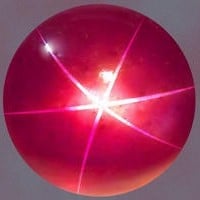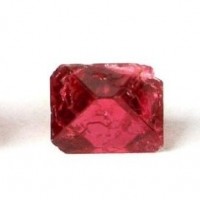Top 10 Gemstones with Phenomenal Optical Effects
What would be better than a great quality gemstone with a great color, size and shape? A gemstone with extra traits, or "special effects". These special optical effects, that are inherent in the mineral, are called "phenomena" by gemologists.This list is about gems that can play with light.
Only 3 out of 100 sapphires produce the optical effect known as asterism (a 6-rayed star) and these phenomenal sapphires are called Star Sapphires. The effect is caused by needle-like rutile inclusions that produce this phenomenon.
Sapphire is one of the greatest gemstones ever (hard and durable) and when it comes with a star, it's even more valued. Star sapphires can occur in different colors and not only in white.
Sapphire Hardness on Mohs Scale: 9.0 (10 is the highest and belongs to the diamonds).

Diamond's "special effect" is called "fire effect" and describes diamond's ability to draw light apart into its constituent colors. It's very similar to the glass prism that unfolds sunlight into the rainbow by refraction.

Its optical effect is even called "alexandrite effect" (aka color change effect) and describes the change of color in sunlight and indoor light.
Alexandrites appear green in daylight and red under incandescent light. This is due to a very strong absorption of certain wavelengths of light.
Alexandrite was named after the Russian tsar Alexander II.
You must have been a science prodigy! Probably one of the more educational TopTens lists.

Hardness on Mohs Scale: 8.5 (still excellent)
Cymophane is a yellow variety of chrysoberyl that produces a cat's eye effect - an optical reflectance effect aka chatoyancy. This is the most precious gem with a cat's eye effect.
When the term "cat's eye" is used by itself as the name of a gemstone, the term refers only to the cat's eye chrysoberyl/cymophane.
But the term "cat's eye" is also used as an adjective which indicates the chatoyance phenomenon in another stone, e.g., cat's eye aquamarine. However, in jewelry industry, only cat's eye chrysoberyl can be referred to as "cat's eye" with no other designation.

You see it looks exactly like the Star Sapphire above, but it's red, with a white star. Also, everything I said about the Star Sapphires applies to the Star Rubies (only 3 out of 100 have a star, the star is 6-rayed, hardness 9.0, rutile inclusions, etc).
The only difference is that Star Rubies are generally only red, or reddish/pinkish.
I didn't put Star Rubies next to Star Sapphires because I didn't want to put 2 gems with the same optical effect in the top 3. But these two gems are very similar because they are varieties of the same mineral - corundum - and share many gemological properties such as hardness, composition and double refraction.

It displays a "play of color" effect (aka schiller effect, a bronzy iridescent luster), where the interior of a stone displays flickers of color as it is moved in the light. There are no actual objects inside the stone. It's just light interfering within the microstructure of the gem.
This effect is called "opalescence" for obvious reasons.
Hardness on Mohs Scale: 5.5 - 6.5 (not very hard and needs care but it's valued for the "play of color" effect).

Tiger's Eye is a gem from the quartz group and the gem was even named for the effect known as "tiger's eye".

It displays a fluorescence effect - under short wave ultraviolet light it fluoresces bright blue. Under long-wave UV light some of them fluoresce red.
Benitoite is a rare and expensive gem named for San Benito County, California, where most of the best Benitoite gems can be found.
(Fluorescence is the ability of a gem to turn incoming light of ultraviolet color into light of a visible color).
Hardness on Mohs Scale: 6 - 6.5

It can produce 2 effects - a cat's eye effect and an alexandrite effect, but tourmaline can't display these effects as good as the classic gems associated with the effects. Still good though.
Hardness on Mohs Scale: 7 - 7.5

Scapolite is a group of gems. Due to its rarity, it is classified as a collector's stone. Some scapolite gemstones can exhibit several effects - cat's eye (very rare and valuable), fluorescence (may be present both in shortwave and longwave), adularescence (soft white glow), and Rainbow effect.

It can form a cat's eye, but it isn't as impressive as in the Cat's Eye Chrysoberyl (the reason aquamarine isn't higher on this list).